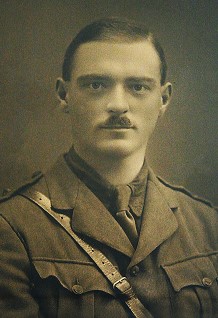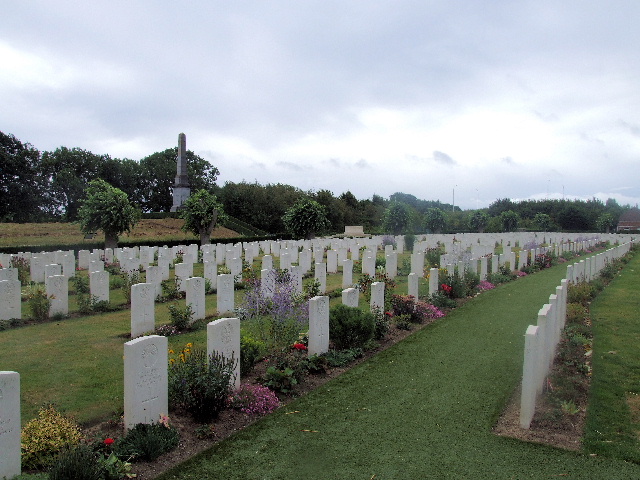Name
Charles Ralph Le-Blanc-Smith
Conflict
First World War
Date of Death / Age
27/11/1915
Rank, Service Number & Service Details
Lieutenant
Rifle Brigade
8th Bn.
Awards: Service Medals/Honour Awards
Not Yet Researched
Cemetery/Memorial: Name/Reference/Country
ESSEX FARM CEMETERY
I. R. 9.
Belgium
Headstone Inscription
Not Researched
UK & Other Memorials
Standon War Memorial,
St Mary’s Church Memorial, Standon,
Photograph and text in Standon Village Hall, Standon,
Puckeridge Memorial Plaque, Standon Village Hall, Standon
Biography
Charles Ralph Le Blanc-Smith was born in the Paddington area of London 3rd March 1890, the first son of Herbert and Gertrude Mary Beatrice Le Blanc-Smith (Beatrice). On 4th May 1890 their new son was baptised at St Mary’s Church, Standon. The family lived at Standon Lordship, and in the baptism entry Herbert is described as ‘Gentleman’. He was in fact a member of the London Stock Exchange, and obviously a man of some wealth and standing. The French ‘Le Blanc’ connection came from Ralph’s paternal grandmother, who was born in Guernsey.
Most villagers will be familiar with the photograph which hangs in the Village Hall at Standon. It shows a handsome young man in uniform, this is C Ralph Le Blanc Smith. The inscription underneath, which cannot easily be read because of the position of the portrait, tells his story, it reads:
"Charles Ralph Le Blanc Smith
Elder son of Mr & Mrs H. Le Blanc Smith (then of Standon Lordship) was born March 3rd 1890, killed in Flanders November 27th 1915.
He was educated at Eton & Trinity College Cambridge, he rowed in the Eton eight in 1908 & 1909 and won the Eton School pairs (with E.E. Loyd) in 1909 in record time, rowed in the Cambridge University eight in 1910, 1911, & 1912, and in the winning crews of the University coxwainless fours of those three years, he won the Colquhoun sculls in 1912 and the Magdalen pairs (with C.E.V. Buxton) in 1913 and was President of the C.V.B.C. in 1912 – 1913 he rowed for Leander in 1910.
He was a cadet officer in the Eton O.T.C. and was also in the Cambridge R.F.A. which he commanded in the Autumn of 1912, the term he took his degree.
When war broke out he was very active in raising subscriptions and securing Volunteers for the Cambridge University Hospital Ship – when it was found German naval tactics afforded no scope for the services of such a ship, he joined the crew of H.M.S. Zarepha, a steam yacht employed in mine sweeping operations in the North Sea, but though an efficient petty officer, he thought that with 7 years of military training, he would be more useful in the Army and in September 1914 he received a commission in the 8th Rifle Brigade, was made machine gun officer, and went to France in May 1915, made full Lieutenant 3rd July, wounded at Hooge on 30th July. It was as Brigade Machine Gun Officer that he was reconnoitring to choose machine-gun positions, (a service for which he had volunteered) when he was shot by a sniper at Willow Walk Turco Farm, then the most advanced position in the Ypres Salient and where the trenches of both sides were close together.
His body was brought back after dark by his men, his funeral was attended by the General and his Staff, his Colonel and Brother Officers and his machine Gunners formed a voluntary guard of honour. The General wrote “He was a very fine young officer, keen, conscientious and fearless, with a thorough knowledge of his work, always cheery and ready to take on any duty.” His Colonel “I personally know I have lost a very great friend, besides a very fine loyal officer, everyone loved him, his unruffled good humour and his delightful courtesy made him popular wherever he went and his men would do anything for him.” His Major “He was a very fine soldier always to the front and giving a lead to his men in whatever the work was and that of a machine gun officer is always dangerous and difficult.” The Sergeant “The loss that the whole machine gun have suffered by losing him, is one that can never be replaced, a cheery word, a helping hand and one who was most respected in the whole battalion, although only a non-commissioned officer myself, I feel I have lost my brother, he was so good & kind to me & us all."
A stone inscription on the outside of Standon Village Hall reads: "This Hall was presented to Standon by H & B Le Blanc-Smith in memory of their elder son Lieut C Ralph Le Blanc-Smith 8th RB. Killed in Action near Ypres 27th November 1915, aged 25 and of the other men of Standon who fell in the Great War 1914-1919."
Acknowledgments
Di Vanderson, Jonty Wild



